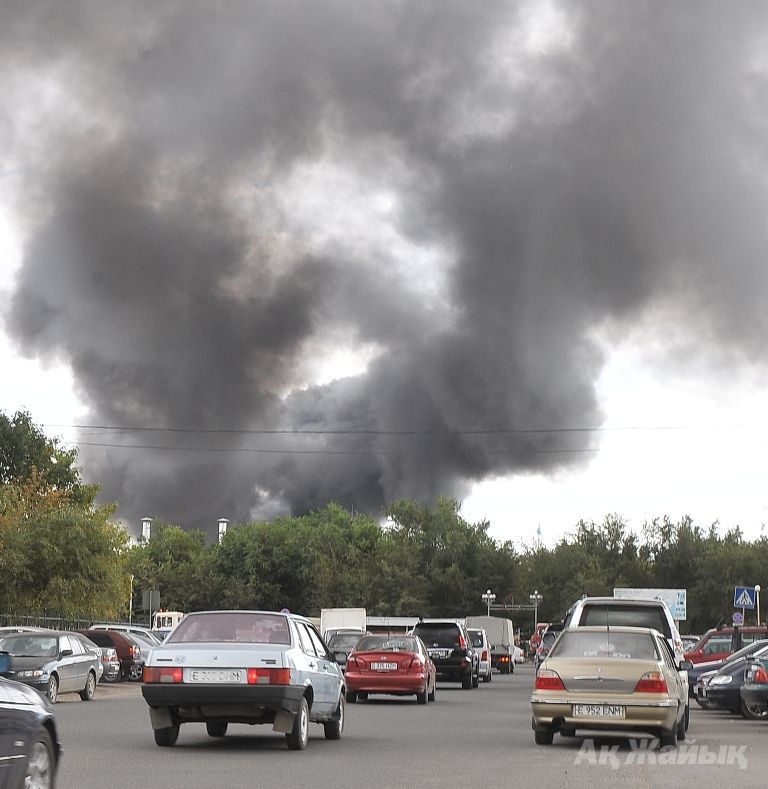 Last Friday, KazTransOil hosted large environmental conference, where, in presence of Chairman of Republican Environmental Regulation and Control Committee Daniyar YERENCHINOV, the head of the oblast environmental department Yerbol KUANOV outlined the current situation and cheerless future of the region in front of subsoil user companies invited.
Last Friday, KazTransOil hosted large environmental conference, where, in presence of Chairman of Republican Environmental Regulation and Control Committee Daniyar YERENCHINOV, the head of the oblast environmental department Yerbol KUANOV outlined the current situation and cheerless future of the region in front of subsoil user companies invited.
NO MONEY FOR CLEANING
Out of annual air emissions (over 100,000 tons, 201kg per head) 85% is released by oil and gas sector entities. Only 0.2% of the amount is being caught and neutralized -- in this our region is the last in the country.
Although environmental legislation prohibits production activities without equipment for cleaning, neutralization and utilization of emissions in place, virtually none of the subsoil users is meeting the requirements -- some of them allegedly due to economical inexpedience.
Among gross perpetrators is Tengizchevroil, which contributes 70% of the oblast's total annual emissions. In the last 5 years, the company spent KZT160bn on environmental protection, but failed to build emission neutralization facilities.
As per Health Department's report, in the last 5 years respiratory diseases rate in the Zhylyoi District has risen by 21%. As a result of occupational hazards, disease rate among TCO employees and its contractors increased, reports health inspection service.
NIGHTMARES
According to the preliminary data of a three-year complex research of Atyrau refinery's and other entities' impact on environment and public health in Atyrau that started in 2010, between 2007 and 2012 there were indicated elevated concentrations of hydrogen sulfide (H2S), sulfur dioxide and nitrogen in surface layer of the atmosphere. H2S content in the air used to exceed limits by 140(!) times, mostly at nights.
The same research established that in the last 20 years people of Atyrau started being sick more often. In particular, disease rate concerning musculoskeletal system increased 9-fold; blood system and blood-making organs - 6-fold; congenital anomalies (development defects) and chromosome defects - 3.8-fold.
Judging by forecasts for 2015, when new oil and gas projects will be launched (TCO's FGP; Bolashak Plant in Karabatan; deep conversion plants and the aromatics production complex at the Atyrau Refinery; petrochemical complex), volume of emissions will increase twice.
PSEUDO-UTILIZATION?
Analysis show that main air contaminators by sulfur (99%), soot (97%) and nitrogen are stationary sources. Mobile sources contribute 94% of benzapyrene emissions -- the number of vehicles in Atyrau has doubled since 2009.
Both kinds of sources emit 48% and 52% of overall formaldehyde emissions respectively.
The city dump is nearly the main problem of our days. In April-September 2012, agencies detected over 40 facts of exceeding maximum allowed limits by mercury (11-fold), formaldehyde (1.2-fold), phenols (2.8-fold), methylmercaptane (9-fold), soot (156-fold) and ammonia (1.5-fold).
Another headache is so called 'Tukhlaya Balka', an area behind Atyrau Refinery to where everything is discharged -- from used fuels and lubricants to waste waters.
Kuanov says oil companies employ the easiest and the most convenient for them method of getting rid of wastes -- they refer this job to specialized companies, although, mostly the latter do not even have temporary waste storage areas, not to mention waste utilization units.
As the result, petroleum wastes are now being discharged anywhere. According to Kuanov, in just last year, these 'specialized' companies buried thousands of tons of wastes in Atyrau Refinery surrounds. At the moment, these places are being examined and the perpetrators will face severe punishment up to cancellation of licenses.
In total, 105,000 tons of petroleum wastes and oil contaminated soil have been accumulated in 28 industrial waste disposal areas.
SINGLE WATERLINE FOR ALL
Kuanov drew attention of the audience to the deficiency of water resources. At the moment, all subsoil users are receiving water from the only Astrakhan-Mangyshlak waterline commissioned 30 years ago. Majority of organizations still hasn't resolved the issue of circulated water supply. For example, Bolashak Plant annually receives 2.6mln cubic meters from the waterline, which then go to evaporation ponds without repeated using. Atyrau Heat & Power Station is irrationally using water too, recycling only 5% of the water (68mln cubic meters) it takes from the Ural River.
He also said large subsoil users are ignoring the issue of cleaning formation waters (See 'Dark waters from inferno'). Not only NCOC, but TCO neglects cleaning and utilization of formation waters as well.
A LA AGIP OPTIMISM
Oppressing silence in the hall emerged following Kuanov's detailed report.
Yerenchinov continued: The situation is serious. We will be tough and decisive. To begin with, we issued negative conclusion on draft maximum permissible limits proposed for Bolashak Plant. I am not inspired by the meeting with Agip KCO management I had today -- I absolutely did not understand what the company is going to do with the issue. They promised to submit package of documents until the end of October. But the problems we raised are so serious that I can't imagine how may they be resolved in just a month.
By Laura SULEIMENOVA
 В Атырау -5
В Атырау -5